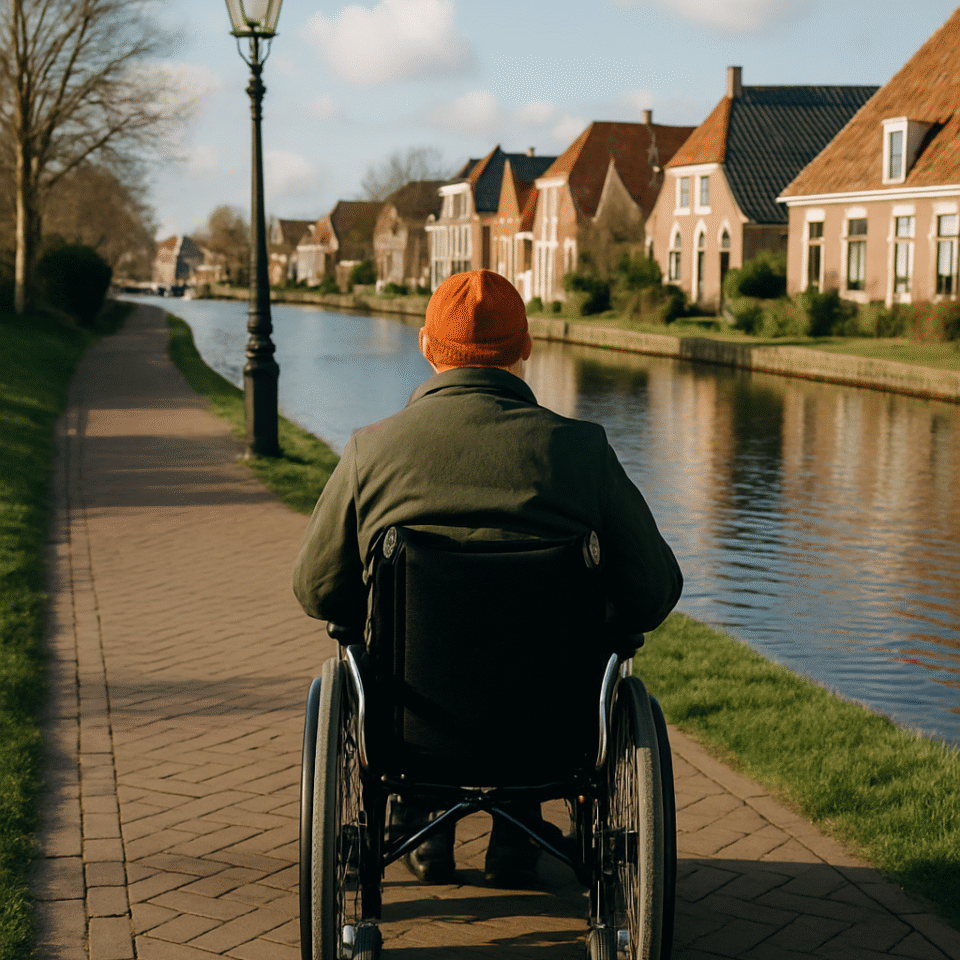I was walking to HEMA the other day when I saw a group of kids playing some kind of wheelchair-based game. It wasn’t immediately clear what the game was, but they were laughing, weaving around cones, and clearly having the time of their lives. And I thought: How rare and quietly radical this is, to see disability not as limitation, but as motion, play, freedom.
It also made me think more seriously about a question that’s lingered since I arrived in the Netherlands: Is this country accessible?
From the outside, it might seem like an ideal place for mobility: flat terrain, compact cities, robust public transport. But like so many things, the truth is layered. This isn’t an expert diagnosis, just one expat’s set of observations, questions, and reflections—a conversation starter for anyone considering life here with mobility or accessibility needs.
The Surface Looks Smooth—But Is It?
At first glance, the Netherlands seems like a dream: no hills, lots of bike lanes, and an infrastructure built for movement. But when you look a little closer, you notice the cracks.
Cobblestone streets are charming until you’re navigating them with wheels; you can literally hear someone pulling their wheeled luggage across the bricks from half a kilometer away, and it doesn’t sound smooth. Entryways to shops and homes are often raised by a step or two, and older buildings rarely have elevators. Even newer apartments sometimes prioritize style over accessibility.
Trains and trams claim to be wheelchair accessible, but implementation is uneven. Some platforms have significant gaps or lack staff to help. Bus ramps work—except when they don’t. And don’t count on public toilets being adapted, especially in older neighborhoods.
There are accessible options. They’re just not everywhere. Not automatic.
A Culture That Doesn’t Coddle (For Better and Worse)
The Dutch approach to disability seems shaped by two cultural tendencies: practicality and minimal fuss. Independence is expected, which can be empowering—but also isolating if you need support.
You won’t see a lot of visible accommodation in daily life. That doesn’t mean it isn’t there, but it’s less foregrounded. People in wheelchairs do use public transport, shop independently, go about their lives—but often by adapting to the system, not the system adapting to them.
Still, the country’s healthcare system offers structural support that can be life-changing. Mobility aids, home modifications, and physical therapy are often well-covered, especially with a huisarts (GP) who advocates for you.
Workarounds and Bright Spots
One thing I’ve seen regularly: those electric mobility scooters—the kind you might see at a Walmart in the U.S.—zipping along bike lanes or sidewalks like it’s no big deal. And here, it really isn’t. And they can be fast…sometimes I’m slightly envious.
The same infrastructure that serves cyclists often becomes a lifeline for people with mobility aids. Bike lanes double as safe, smooth routes for electric chairs and scooters. The sidewalks are usually wide enough to share. The culture’s general respect for personal space and low-speed travel helps, too.
That moment watching kids play in wheelchairs still stands out to me. Whether it was a physical therapy session or just pure play, it offered a rare image of movement framed by joy instead of limitation. I sincerely don’t know if these children were actually handicapped or were merely learning how wheelchairs work or what it’s like to use one; I certainly hope the latter, but I absolutely refrained from inquiring.
Old Bones, New Demands
One major difference between accessibility in the Netherlands and the U.S. is historical context. Much of American infrastructure was built or rebuilt in the era of wheelchairs, curb cuts, and ADA compliance. In the Netherlands, you’re working with medieval bones. Streets, buildings, and neighborhoods were designed centuries before modern mobility aids existed.
This isn’t an excuse, but it does explain some of the retrofitting struggles. Accessibility here often means adapting ancient architecture to modern life, which isn’t always straightforward. Just driving a modern day car here can feel extremely limited relative to the wide, double lane streets we’re used to in the States, let alone navigating the centuries-old infrastructure in a manually powered wheelchair.
Still, the intention matters. And sometimes that intention shows up more slowly than it should.
If You’re Moving Here With a Disability
Here are a few things to research or prepare:
- Where you live matters. Newer developments tend to have elevators, ramps, and better public transport access. Older city centers, while beautiful, can be much harder to navigate.
- Healthcare and mobility support exist but require paperwork and persistence. Having a Dutch-speaking advocate can make a huge difference.
- Transit is usable but call ahead if you need guaranteed access to certain services, especially train platforms.
- Online communities can offer vital, lived-experience advice. Look for Dutch disability advocacy groups, or local expat forums focused on accessibility.
Closing Thoughts: Accessibility Isn’t Just a Checklist
What I’ve come to understand is that accessibility isn’t just about infrastructure. It’s about dignity, spontaneity, and the ability to participate in everyday life without extraordinary effort.
The Netherlands has strong spots and blind spots. It has thoughtful policies and tricky thresholds. It’s not perfect. But it’s evolving. And perhaps most importantly, there are people here—locals, expats, kids in wheelchairs playing outside—who are shaping that evolution every day.
Do you have firsthand experience with disability or mobility in the Netherlands? I’d genuinely love to hear from you. These reflections are just a starting point—the fuller story is still being written.








